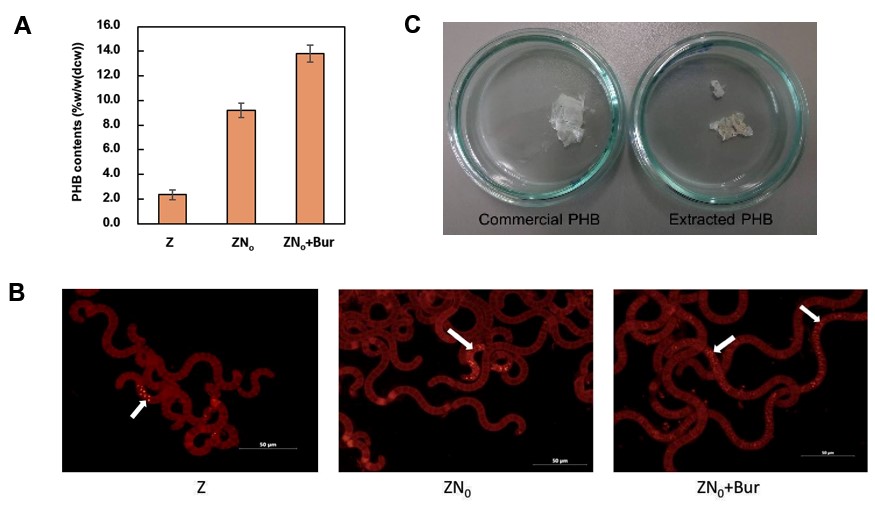ผลของการเสริมบิวทิเรตต่อการผลิตสารมูลค่าสูงซี–ไฟโคไซยานินและพอลิไฮดรอกซีบิวทิเรตในสไปรูลิน่า พลาเทนซิส
Main Article Content
Abstract
Downloads
Article Details

This work is licensed under a Creative Commons Attribution-NonCommercial 4.0 International License.
References
Ansari, S., and Fatma, T. (2016). Cyanobacterial polyhydroxybutyrate (PHB): Screening, optimization and characterization. PLoS ONE 11(6): e0158168.
Bengtsson, S., Pisco, A. R., Reis, M. A. M., and Lemos, P. C. (2010). Production of polyhydroxyalkanoates from fermented sugar cane molasses by a mixed culture enriched in glycogen accumulating organisms. Journal of Biotechnology 145(3): 253–263.
Bennett, A., and Bogorad, L. (1973). Complementary chromatic adaptation in a fila-menttous blue–green alga. Journal of Cell Biology 58(2): 419–435.
Bugnicourt, E., Cinelli, P., Lazzeri, A., and Alvarez, V. (2014). Polyhydroxyalkanoate (PHA): Review of synthesis, characteristics, processing and potential applications in packaging. Express Polymer Letters 8(11): 791–808.
Chen, T., Zheng, W., Yang, F., Bai, Y., and Wong, Y.–S. (2006). Mixotrophic culture of high selenium–enriched Spirulina platensis on acetate and the enhanced production of photosynthetic pigments. Enzyme and Microbial Technology 39(1): 103–107.
Depraetere, O., Pierre, G., Deschoenmaeker, F., Badri, H., Foubert, I., Leys, N., Markou, G., Wattiez, R., Michaud, P., Muylaert, K. (2015) Harvesting carbohydrate–rich Arthrospira platensis by spontaneous settling. Bioresource Technology 180: 16–21.
Deschoenmaeker, F., Facchini, R., Cabrera–Pino, J. C., Bayon–Vicente, G., Sachdeva, N., Flammang, P., and Wattiez, R. (2016). Nitrogen depletion in Arthrospira sp. PCC 8005, an ultrastructural point of view. Journal of Structural Biology 196(3): 385–393.
Duangsri, C., and Raksajit, W. (2016). Polyhydroxyalkanoates: An alternative biomaterial for renewable plastic. Journal of Research Unit on Science, Technology and Environment for Learning 7(2): 414–423.
Eriksen, N. T. (2008). Production of phycocyanin – A pigment with applications in biology, biotechnology, foods and medicine. Applied Microbiology and Biotechnology 80(1): 1–14.
Kedia, G., Passanha, P., Dinsdale, R. M., Guwy, A. J., and Esteves, S. R. (2014). Evaluation of feeding regimes to enhance PHA production using acetic and butyric acids by a pure culture of Cupriavidus necator. Biotechnology and Bioprocess Engi-neering 19(6): 989–995.
Koch, M., Doello, S., Gutekunst, K., and Forchhammer, K. (2019). PHB is produced from Glycogen turn–over during nitrogen starvation in Synechocystis sp. PCC 6803. International Journal of Molecular Sciences 20(8): 1942.
Kuddus, M., Singh, P., Thomas, G., and Al–Hazimi, A. (2013). Recent developments in production and biotechnological applications of c–phycocyanin. BioMed Research International 2013: 742859.
Limoli, D. H., Jones, C. J., and Wozniak, D. J. (2015). Bacterial extracellular polysaccharides in biofilm formation and function. Microbiology Spectrum 3(3): MB–0011–2014.
Mansouri, H., and Talebizadeh, R. (2017). Effects of indole–3–butyric acid on growth, pigments and UV–screening compounds in Nostoc linckia. Phycological Research 65(3): 212–216.
Martins, R. G., Severo Gonçalves, I., de Morais, M. G., and Costa, J. A. V. (2014). Bio-process engineering aspects of biopolymer production by the cyanobacterium Spirulina strain LEB 18. International Journal of Polymer Science 2014: 895237.
Masood, F., Yasin, T., and Hameed, A. (2014). Comparative oxo–biodegradation study of poly–3-hydroxybutyrate–co–3–hydroxyvalerate/polypropylene blend in controlled environments. International Biodeterioration and Biodegradation 87: 1–8.
Monshupanee, T., and Incharoensakdi, A. (2014). Enhanced accumulation of glycogen, lipids and polyhydroxybutyrate under optimal nutrients and light intensities in the cyanobacterium Synechocystis sp. PCC 6803. Journal of Applied Microbiology 116(4): 830–838.
Omar, H. H., Aly, M. M., Al–Malki, W. J., and Balkhair, K. S. (2016). Production and enhancement of poly–β–hydroxybutyrate in cyanobacteria. Main Group Chemistry 15(2): 153–161.
Raksajit, W., Satchasataporn, K., Lehto, K., Mäenpää, P., and Incharoensakdi, A. (2012). Enhancement of hydrogen production by the filamentous non–heterocystous cyanobacterium Arthrospira sp. PCC 8005. Inter-national Journal of Hydrogen Energy 37(24): 18791–18797.
Raza, Z. A., Abid, S., and Banat, I. M. (2018). Polyhydroxyalkanoates: Characteristics, production, recent developments and applications. International Biodeterioration & Biodegradation 126: 45–56.
Sanhueza, C., Acevedo, F., Rocha, S., Vil-legas, P., Seeger, M., and Navia, R. (2019). Polyhydroxyalkanoates as biomaterial for electrospun scaffolds. International Journal of Biological Macromolecules 124: 102–110.
Shanmugam, A., Sigamani, S., Venkatachalam, H., Jayaraman, J. D., and Ramamurthy, D. (2017). Antibacterial activity of extracted phycocyanin from Oscillatoria sp. Journal of Applied Pharmaceutical Science 7(3): 62–67.
Schlebusch, M., and Forchhammer, K. (2010). Requirement of the nitrogen starvation–induced protein s110783 for polyhydroxybutyrate accumulation in Synechocystis sp. strain PCC 6803. Applied and Environmental Microbiology 76(18): 6101–6107.
Sharma, G., Kumar, M., Ali, M. I., and Jasuja, N. D. (2014). Effect of carbon content, salinity and pH on Spirulina platensis for phycocyanin, allophycocyanin and phycoerythrin accumulation. Journal of Microbial and Biochemical Technology. 6(4): 202–206.
Shrivastav, A., Mishra, S. K., and Mishra, S. (2010). Polyhydroxyalkanoate (PHA) synthesis by Spirulina subsalsa from Gujarat coast of India. International Journal of Biological Macromolecules 46(2): 255–260.
Sitohy, M., Osman, A., Ghany, A. G. A., and Salama, A. (2015). Antibacterial phycocyanin from Anabaena oryzae SOS13. International Journal of Applied Research in Natural Products 8(4): 27–36.
Vasudevan, V., Prasanna, R., Sood, A., and Kaushik, B. D. (2007). Enhancing pigment accumulation in Anabaena strains using sugars. Acta Botanica Hungarica 49 (1–2): 187–198.
Zhang, X.–W., Zhang, Y.–M., and Chen, F. (1999). Application of mathematical models to the determination optimal glucose concentration and light intensity for mixotrophic culture of Spirulina platensis. Process Biochemistry 34(5): 477–481.
